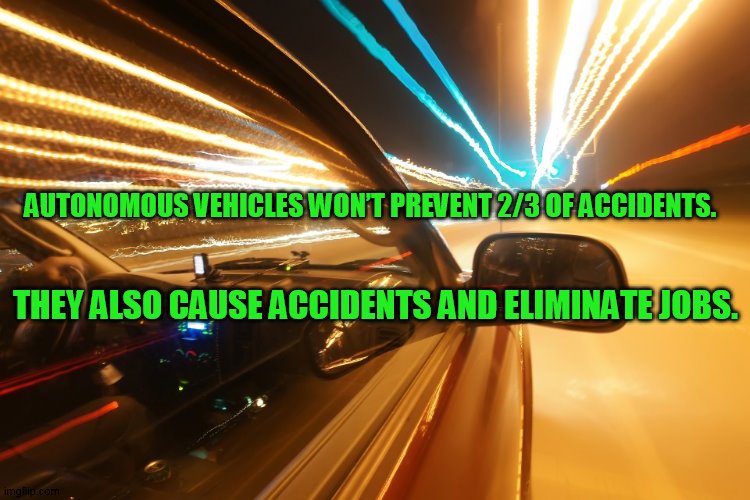 By B.N. Frank
By B.N. Frank
Are you concerned about safety risks associated with Autonomous Vehicles (AVs) (see 1, 2, 3)? What about their potential to increase pollution and traffic congestion? If so, you are not alone. In fact, there was a congressional meeting held recently to discuss these topics and more.
From Smart Cities Dive:
Concerns about safe deployment of autonomous vehicles aired at Congressional hearing
Dan Zukowski Reporter
Dive Brief:
- Federal lawmakers, city officials and industry representatives discussed the future for automated vehicles in a subcommittee hearing on Wednesday convened by the U.S. House of Representatives Transportation and Infrastructure Committee. With pilot projects already underway in several communities, officials seek broad cooperation among city, state and federal governments in addressing safety, equity and funding.
- While industry representatives praised the potential benefits of automated vehicles (AVs), speakers reflecting the views of state and local government organizations expressed concerns about costs, congestion and the readiness of their communities for the coming technology in automobiles and commercial vehicles.
- One witness disputed the safety claims often made for autonomous vehicles. “To date, the approach of pursuing voluntary industry agreements, sometimes with government agency involvement, consistently has been demonstrated to be insufficient to ensure public safety,” said Catherine Chase, president of the Advocates for Highway and Auto Safety.
Dive Insight:
With partially automated vehicles already on streets in San Francisco, Phoenix, Houston and elsewhere, transportation leaders are tackling new challenges. “Regulators must do their part to hold industry accountable in this process and ensure that AVs deliver on their promise of safer roads,” said committee chair Rep. Peter DeFazio, D-Oregon, in a statement.
Eleanor Holmes Norton, D-District of Columbus, chair of the Highways and Transit Subcommittee, explained that Wednesday’s hearing was to examine the effect of these vehicles on safety, infrastructure and the workforce, as well as the committee’s role in overseeing deployment.
Scott Marler, director of the Iowa Department of Transportation, appearing on behalf of the American Association of State Highway and Transportation Officials, said the lobby association believes, “To fully realize the benefits of automated transportation, AASHTO member states believe that vehicles must be more than automated, they must also be connected.”
Marler’s reference to connected vehicles — those that can communicate with other vehicles, traffic signals, hazard warnings and other devices — is an area of concern for municipalities that own such infrastructure.
Martha Castex-Tatum, vice mayor pro tem and council member for the city of Houston, speaking on behalf of the National League of Cities, said cities are looking to create the right environment for autonomous transportation. But she also noted that current AVs are designed to operate in today’s environment, and warned that if cities had to redesign their roads or install expensive technology, “the cost for local governments who own and maintain the majority of the nation’s roads, streets and sidewalks would be untenable.”
The NLC has three recommendations, Castex-Tatum said, for federal action that will promote safe AV testing. These include investing in pilot programs with local governments; workforce training for the jobs that automated vehicle technologies will create; and transportation planning, logistics and technology.
But Chase noted that there are presently no federal performance standards for autonomous vehicles or for advanced driver assistance systems such as emergency braking or lane departure warning. The same goes for partial automation, which is already available in some vehicles currently on the market. Because of that, she said, there are no safety standards to ensure that these systems perform as needed.
Nico Larco is a professor and the director of the Urbanism Next Center at the University of Oregon. “One thing that is certain,” he said, “is the need to pay attention to AVs’ transportation impacts as well as the cascading impacts they will have on communities.”
Among the issues he cited is the possibility that self-driving vehicles rack up empty miles and thereby add to congestion. For example, instead of paying for parking, a driver could send their self-driving car on a loop until they need it again. Larco also said that automated vehicles could either complement or compete with public transportation. For instance, a commuter could get to work by car while getting work done during the drive, a benefit previously reserved for train riders.
Larco added that the availability of self-driving vehicles could also encourage people to move farther away from city centers, increasing sprawl.
“Our AV future is not preordained, it is ours to shape,” said Larco. “But we can only adequately shape the future if we understand not only the technical requirements of AVs or the regulations enabling deployment but also the cascading impacts AVs will have on our communities.”
Follow Dan Zukowski on Twitter
Of course, some people (including health experts) are concerned about the impact of electromagnetic radiation emissions from Autonomous Vehicles too (see 1, 2, 3).
Activist Post reports regularly about AVs and unsafe technology. For more information, visit our archives and the following websites:
- Wireless Information Network
- Electromagnetic Radiation Safety
- Environmental Health Trust
- Physicians for Safe Technology
Become a Patron!
Or support us at SubscribeStar
Donate cryptocurrency HERE
Subscribe to Activist Post for truth, peace, and freedom news. Follow us on Telegram, HIVE, Flote, Minds, MeWe, Twitter, Gab, What Really Happened and GETTR.
Provide, Protect and Profit from what’s coming! Get a free issue of Counter Markets today.
Concerns about Automated Vehicles Discussed at Congressional Hearing